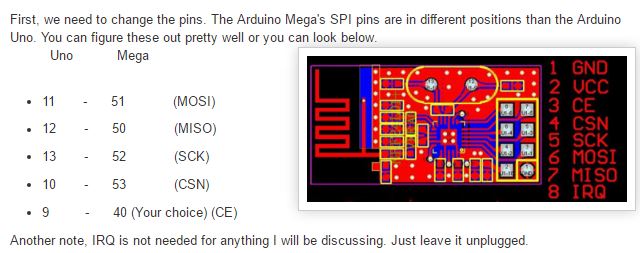Hello,
Have been having problem trying to get atleast 2 nodes to work properly and I can't seems to figure out the problem/solution.
I have the Ardunio Uno as my serial gateway connected to the NRF24L01+ radio with a 10uf cap using the 2.0 GatewaySerial example (unchanged and even changed :)).
Have checked the pins for continuity and voltage drop where everything seems okay.
On the sensor node side, I have an Arduino Mega 2560 connected to the same NRF24L01+ 2.4GHz radio powered by an external 3.3V regulator.
On the sensor node am running the default dust sensors code adding just a modification of static node id of 6 and arduino mega CS and CE radio pins
What I've tried: Swapping the codes between the 2 arduino boards, trying out another type of the nrf24l01+ radio, moving the node further away from the gateway, moving the node and gateway closer, trying other example similar codes for the sensor node.
I don't have a controller, so I've hard-coded the node ID and parent id with #define MY_NODE_ID 6 and #define MY_PARENT_NODE_ID 0 for the sensor node not sure if that's necessary for the gateway device.
At the end am hoping to build my own limited controller powered by the Arduino mega or Due incorporating the Nextion touch Display for User Interface.
So, when I start the two monitors up within a few seconds of each other (gateway first), here's the output of the gateway:
Gateway log messages
0;255;3;0;9;Starting gateway (RNNGA-, 2.0.0)
0;255;3;0;9;TSM:INIT
0;255;3;0;9;TSM:RADIO:OK
0;255;3;0;9;TSM:GW MODE
0;255;3;0;9;TSM:READY
0;255;3;0;14;Gateway startup complete.
0;255;0;0;18;2.0.0
0;255;3;0;9;No registration required
0;255;3;0;9;Init complete, id=0, parent=0, distance=0, registration=1
0;255;3;0;9;TSP:MSG:READ 6-6-255 s=255,c=3,t=7,pt=0,l=0,sg=0:
0;255;3;0;9;TSP:MSG:BC
0;255;3;0;9;TSP:MSG:FPAR REQ (sender=6)
0;255;3;0;9;TSP:CHKUPL:OK
0;255;3;0;9;TSP:MSG:GWL OK
0;255;3;0;9;!TSP:MSG:SEND 0-0-6-6 s=255,c=3,t=8,pt=1,l=1,sg=0,ft=0,st=fail:0
0;255;3;0;9;TSP:MSG:READ 6-6-255 s=255,c=3,t=7,pt=0,l=0,sg=0:
0;255;3;0;9;TSP:MSG:BC
0;255;3;0;9;TSP:MSG:FPAR REQ (sender=6)
0;255;3;0;9;TSP:CHKUPL:OK (FLDCTRL)
0;255;3;0;9;TSP:MSG:GWL OK
0;255;3;0;9;!TSP:MSG:SEND 0-0-6-6 s=255,c=3,t=8,pt=1,l=1,sg=0,ft=0,st=fail:0
0;255;3;0;9;TSP:MSG:READ 6-6-255 s=255,c=3,t=7,pt=0,l=0,sg=0:
0;255;3;0;9;TSP:MSG:BC
0;255;3;0;9;TSP:MSG:FPAR REQ (sender=6)
0;255;3;0;9;TSP:CHKUPL:OK (FLDCTRL)
0;255;3;0;9;TSP:MSG:GWL OK
0;255;3;0;9;!TSP:MSG:SEND 0-0-6-6 s=255,c=3,t=8,pt=1,l=1,sg=0,ft=0,st=fail:0
0;255;3;0;9;TSP:MSG:READ 6-6-255 s=255,c=3,t=7,pt=0,l=0,sg=0:
0;255;3;0;9;TSP:MSG:BC
0;255;3;0;9;TSP:MSG:FPAR REQ (sender=6)
0;255;3;0;9;TSP:CHKUPL:OK (FLDCTRL)
0;255;3;0;9;TSP:MSG:GWL OK
0;255;3;0;9;!TSP:MSG:SEND 0-0-6-6 s=255,c=3,t=8,pt=1,l=1,sg=0,ft=0,st=fail:0
0;255;3;0;9;TSP:MSG:READ 6-6-255 s=255,c=3,t=7,pt=0,l=0,sg=0:
0;255;3;0;9;TSP:MSG:BC
0;255;3;0;9;TSP:MSG:FPAR REQ (sender=6)
0;255;3;0;9;TSP:CHKUPL:OK
0;255;3;0;9;TSP:MSG:GWL OK
0;255;3;0;9;!TSP:MSG:SEND 0-0-6-6 s=255,c=3,t=8,pt=1,l=1,sg=0,ft=0,st=fail:0
0;255;3;0;9;TSP:MSG:READ 6-6-255 s=255,c=3,t=7,pt=0,l=0,sg=0:
0;255;3;0;9;TSP:MSG:BC
0;255;3;0;9;TSP:MSG:FPAR REQ (sender=6)
0;255;3;0;9;TSP:CHKUPL:OK (FLDCTRL)
0;255;3;0;9;TSP:MSG:GWL OK
0;255;3;0;9;!TSP:MSG:SEND 0-0-6-6 s=255,c=3,t=8,pt=1,l=1,sg=0,ft=0,st=fail:0
0;255;3;0;9;TSP:SANCHK:OK
0;255;3;0;9;TSP:MSG:READ 6-6-255 s=255,c=3,t=7,pt=0,l=0,sg=0:
0;255;3;0;9;TSP:MSG:BC
Output from the Arduino Mega 2560 Sensor node
NOde Log Message
Starting sensor (RNNNA-, 2.0.0)
TSM:INIT
TSM:RADIO:OK
TSP:ASSIGNID:OK (ID=6)
TSM:FPAR
TSP:MSG:SEND 6-6-255-255 s=255,c=3,t=7,pt=0,l=0,sg=0,ft=0,st=bc:
TSM:FPAR
TSP:MSG:SEND 6-6-255-255 s=255,c=3,t=7,pt=0,l=0,sg=0,ft=0,st=bc:
TSM:FPAR
TSP:MSG:SEND 6-6-255-255 s=255,c=3,t=7,pt=0,l=0,sg=0,ft=0,st=bc:
TSM:FPAR
TSP:MSG:SEND 6-6-255-255 s=255,c=3,t=7,pt=0,l=0,sg=0,ft=0,st=bc:
!TSM:FPAR:FAIL
!TSM:FAILURE
TSM:PDT
TSM:INIT
TSM:RADIO:OK
TSP:ASSIGNID:OK (ID=6)
TSM:FPAR
TSP:MSG:SEND 6-6-255-255 s=255,c=3,t=7,pt=0,l=0,sg=0,ft=0,st=bc:
TSM:FPAR
TSP:MSG:SEND 6-6-255-255 s=255,c=3,t=7,pt=0,l=0,sg=0,ft=0,st=bc:
TSM:FPAR
TSP:MSG:SEND 6-6-255-255 s=255,c=3,t=7,pt=0,l=0,sg=0,ft=0,st=bc:
TSM:FPAR
TSP:MSG:SEND 6-6-255-255 s=255,c=3,t=7,pt=0,l=0,sg=0,ft=0,st=bc:
!TSM:FPAR:FAIL
!TSM:FAILURE
TSM:PDT
TSM:INIT
TSM:RADIO:OK
TSP:ASSIGNID:OK (ID=6)
TSM:FPAR
TSP:MSG:SEND 6-6-255-255 s=255,c=3,t=7,pt=0,l=0,sg=0,ft=0,st=bc:
TSM:FPAR
TSP:MSG:SEND 6-6-255-255 s=255,c=3,t=7,pt=0,l=0,sg=0,ft=0,st=bc:
TSM:FPAR
TSP:MSG:SEND 6-6-255-255 s=255,c=3,t=7,pt=0,l=0,sg=0,ft=0,st=bc:
TSM:FPAR
TSP:MSG:SEND 6-6-255-255 s=255,c=3,t=7,pt=0,l=0,sg=0,ft=0,st=bc:
!TSM:FPAR:FAIL
!TSM:FAILURE
TSM:PDT
TSM:INIT
TSM:RADIO:OK
TSP:ASSIGNID:OK (ID=6)
TSM:FPAR
TSP:MSG:SEND 6-6-255-255 s=255,c=3,t=7,pt=0,l=0,sg=0,ft=0,st=bc:
TSM:FPAR
TSP:MSG:SEND 6-6-255-255 s=255,c=3,t=7,pt=0,l=0,sg=0,ft=0,st=bc:
TSM:FPAR
TSP:MSG:SEND 6-6-255-255 s=255,c=3,t=7,pt=0,l=0,sg=0,ft=0,st=bc:
TSM:FPAR
TSP:MSG:SEND 6-6-255-255 s=255,c=3,t=7,pt=0,l=0,sg=0,ft=0,st=bc:
!TSM:FPAR:FAIL
!TSM:FAILURE
TSM:PDT
This is the code preview of the dust sensor running on the Arduino Mega 2560
#define MY_DEBUG
#define MY_RADIO_NRF24
// Optional for Arduino Mega only
#define MY_RF24_CS_PIN 53
#define MY_RF24_CE_PIN 40
#define MY_NODE_ID 6
#define MY_PARENT_NODE_ID 0
//#define MY_PARENT_NODE_IS_STATIC
#include <SPI.h>
#include <MySensors.h>
#define CHILD_ID_DUST 0
#define DUST_SENSOR_ANALOG_PIN 1
unsigned long SLEEP_TIME = 3*1000; // Sleep time between reads (in milliseconds)
//VARIABLES
int val = 0; // variable to store the value coming from the sensor
float valDUST =0.0;
float lastDUST =0.0;
int samplingTime = 280;
int deltaTime = 40;
int sleepTime = 9680;
float voMeasured = 0;
float calcVoltage = 0;
float dustDensity = 0;
MyMessage dustMsg(CHILD_ID_DUST, V_LEVEL);
void presentation() {
// Send the sketch version information to the gateway and Controller
sendSketchInfo("Dust Sensor", "1.1");
// Register all sensors to gateway (they will be created as child devices)
present(CHILD_ID_DUST, S_DUST);
}
void loop() {
uint16_t voMeasured = analogRead(DUST_SENSOR_ANALOG_PIN);// Get DUST value
// 0 - 5V mapped to 0 - 1023 integer values
// recover voltage
calcVoltage = voMeasured * (5.0 / 1024.0);
// linear eqaution taken from http://www.howmuchsnow.com/arduino/airquality/
// Chris Nafis (c) 2012
dustDensity = (0.17 * calcVoltage - 0.1)*1000;
Serial.print("Raw Signal Value (0-1023): ");
Serial.print(voMeasured);
Serial.print(" - Voltage: ");
Serial.print(calcVoltage);
Serial.print(" - Dust Density: ");
Serial.println(dustDensity); // unit: ug/m3
if (ceil(dustDensity) != lastDUST) {
send(dustMsg.set((int)ceil(dustDensity)));
lastDUST = ceil(dustDensity);
}
sleep(SLEEP_TIME);
}
This is the gateway code
#define MY_DEBUG
// Enable and select radio type attached
#define MY_RADIO_NRF24
//#define MY_RADIO_RFM69
//#define MY_NODE_ID 1
//#define MY_PARENT_NODE_ID 0
#define MY_RF24_PA_LEVEL RF24_PA_LOW
// Enable serial gateway
#define MY_GATEWAY_SERIAL
// Define a lower baud rate for Arduino's running on 8 MHz (Arduino Pro Mini 3.3V & SenseBender)
#if F_CPU == 8000000L
#define MY_BAUD_RATE 38400
#endif
// Enable inclusion mode
#define MY_INCLUSION_MODE_FEATURE
// Enable Inclusion mode button on gateway
//#define MY_INCLUSION_BUTTON_FEATURE
// Inverses behavior of inclusion button (if using external pullup)
//#define MY_INCLUSION_BUTTON_EXTERNAL_PULLUP
// Set inclusion mode duration (in seconds)
#define MY_INCLUSION_MODE_DURATION 60
// Digital pin used for inclusion mode button
//#define MY_INCLUSION_MODE_BUTTON_PIN 3
// Set blinking period
#define MY_DEFAULT_LED_BLINK_PERIOD 300
// Inverses the behavior of leds
//#define MY_WITH_LEDS_BLINKING_INVERSE
#include <MySensors.h>
void setup() {
// Setup locally attached sensors
}
void presentation() {
// Present locally attached sensors
}
void loop() {
// Send locally attached sensor data here
}
From what I believe is happening is that the sensor node is trying to request for the Parent address I think and the Gateway sees that sensor node request but somehow failed to respond to request. Also am still worried why the sensor node is actually trying to request for the parent id when it has already been hardcoded into the senor code as
#define MY_PARENT_NODE_ID 0
I believe their must be something I am dong wrong here?? or something I am not seeing well.
Any help to make these all work will be appreciated.


